













|
A NASA research team of scientists at the Johnson Space Center and at Stanford University has found evidence that strongly suggests primitive life may have existed on Mars more than 3.6 billion years ago.
The NASA-funded team found the first organic molecules thought to be of
Martian origin; several mineral features characteristic of biological
activity; and possible microscopic fossils of primitive, bacteria-like
organisms inside of an ancient Martian rock that fell to Earth as a meteorite.
This array of indirect evidence of past life will be reported in the
August 16 issue of the journal Science, presenting the
investigation to the scientific community at large to reach a future
consensus that will either confirm or deny the team's conclusion.
| Photographic Evidence |
|---|
Following are photographic evidences for the discovery of primitive life on Mars.
 Mars Life? - Microscopic Structures
Mars Life? - Microscopic Structures
In the center of this electron microscope image of a small
chip from a meteorite are several tiny structures that are possible
microscopic fossils of primitive, bacteria-like organisms that may have
lived on Mars more than 3.6 billion years ago. A two-year investigation
by a NASA research team found organic molecules, mineral features
characteristic of biological activity and possible microscopic fossils
such as these inside of an ancient Martian rock that fell to Earth as a
meteorite. The largest possible fossils are less than 1/100th the
diameter of a human hair in size while most are ten times smaller.
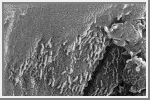 Microscopic Tube-like Structures
Microscopic Tube-like Structures
This electron microscope image is a close-up of the center
part of photo number S96-12301. While the exact nature of these
tube-like structures is not known, one interpretation is that they may
be microscopic fossils of primitive, bacteria-like organisms that may
have lived on Mars more than 3.6 billion years ago. A two-year
investigation by a NASA research team found organic molecules, mineral
features characteristic of biological activity and possible microscopic
fossils such as these inside of an ancient Martian rock that fell to
Earth as a meteorite. The largest possible fossils are less than
1/100th the diameter of a human hair in size while most are ten times
smaller.
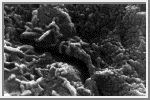 Microscopic Tubular Structures
Microscopic Tubular Structures
This electron microscope image shows extremely tiny tubular
structures that are possible microscopic fossils of bacteria-like
organisms that may have lived on Mars more than 3.6 billion years ago.
A two-year investigation by a NASA research team found organic
molecules, mineral features characteristic of biological activity and
possible microscopic fossils such as these inside of an ancient Martian
rock that fell to Earth as a meteorite. The largest possible fossils
are less than 1/100th the diameter of a human hair in size while most
are ten times smaller. The fossil-like structures were found in
carbonate minerals formed along pre-existing fractures in the meteorite
in a fashion similar to the way fossils occur in limestone on Earth,
although on a microscopic scale.
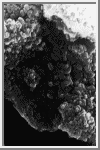 Microscopic Egg-shaped Structures
Microscopic Egg-shaped Structures
This electron microscope image shows egg-shaped structures, some of
which may be possible microscopic fossils of Martian origin as
discussed by NASA research published in the Aug. 16, 1996, issue of the
journal Science. A two-year investigation found organic molecules,
mineral features characteristic of biological activity and possible
microscopic fossils such as these inside of an ancient Martian rock
that fell to Earth as a meteorite. The largest possible fossils are
less than 1/100th the diameter of a human hair in size while most are
ten times smaller.
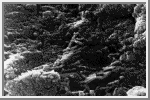 Microscopic Tubular Structures
Microscopic Tubular Structures
This electron microscope image shows tubular structures of likely
Martian origin. These structures are very similar in size and shape to
extremely tiny microfossils found in some Earth rocks. This photograph
is part of a report by a NASA research team published in the Aug. 16,
1996, issue of the journal Science. A two-year investigation by the
team found organic molecules, mineral features characteristic of
biological activity and possible microscopic fossils such as these
inside of an ancient Martian rock that fell to Earth as a meteorite.
The largest possible fossils are less than 1/100th the diameter of a
human hair in size while most are ten times smaller.
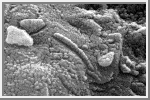
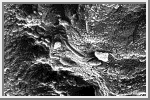 Microscopic Tube-like Structures
Microscopic Tube-like Structures
This high-resolution scanning electron microscope image shows an
unusual tube-like structural form that is less than 1/100th the width
of a human hair in size found in meteorite ALH84001, a meteorite
believed to be of Martian origin. Although this structure is not part
of the research published in the Aug. 16 issue of the journal Science,
it is located in a similar carbonate glob in the meteorite. This
structure will be the subject of future investigations that could
confirm whether or not it is fossil evidence of primitive life on Mars
3.6 billion years ago.
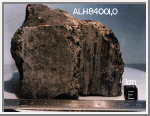 Meterorite ALH84001
Meterorite ALH84001
This 4.5 billion-year-old rock, labeled meteorite ALH84001, is
believed to have once been a part of Mars and to contain fossil
evidence that primitive life may have existed on Mars more than 3.6
billion years ago. The rock is a portion of a meteorite that was
dislodged from Mars by a huge impact about 16 million years ago and
that fell to Earth in Antarctica 13,000 years ago. The meteorite was
found in Allan Hills ice field, Antarctica, by an annual expedition of
the National Science Foundation's Antarctic Meteorite Program in 1984.
It is preserved for study at the Johnson Space Center's Meteorite
Processing Laboratory in Houston.
 Orange-colored Carbonate Mineral Globules
Orange-colored Carbonate Mineral Globules
This photograph shows orange-colored carbonate mineral globules
found in a meteorite, called ALH84001, believed to have once been a
part of Mars. These carbonate minerals in the meteorite are believed to
have been formed on Mars more than 3.6 billion years ago. Their
structure and chemistry suggest that they may have been formed with the
assistance of primitive, bacteria-like living organisms. A two-year
investigation by a NASA research team found organic molecules, mineral
features characteristic of biological activity and possible microscopic
fossils inside of carbonate minerals such as these in the meteorite.
Views of the Solar System Copyright © 1997-2000 by Calvin J. Hamilton. All rights reserved. Privacy Statement.